Last Updated on April 4, 2024
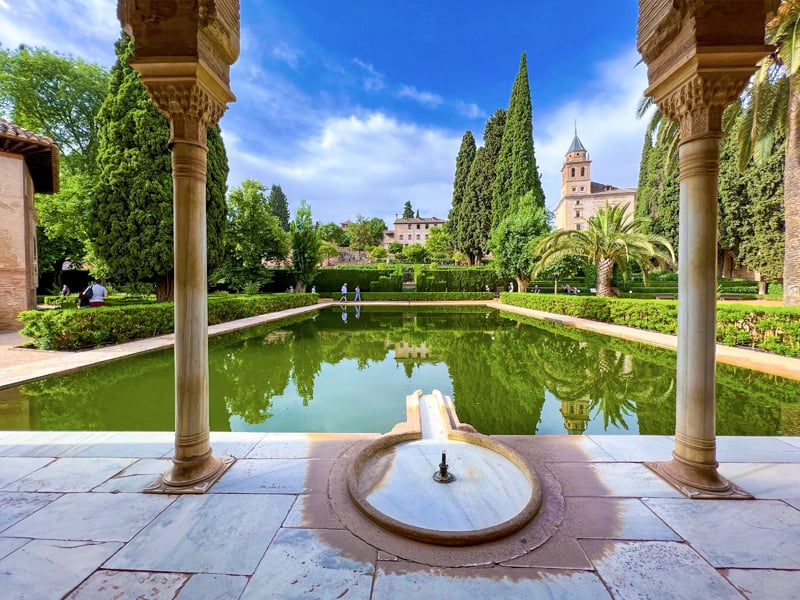
By Jim Ferri
In the foothills of Spain’s Sierra Nevada, Granada offers travelers plenty of things to do.
Molded by Moorish rulers and Catholic kings into the Andalusian hot spot it is today, the city exudes a tantalizing Spanish and Moorish flavor.
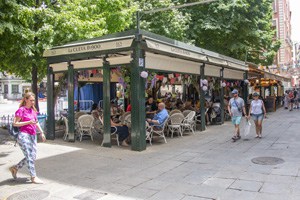
Visit – even if, like me, you only have two days – and you’ll quickly realize why. It has interesting shops, excellent tapas bars, and shady city squares, the latter most welcomed on hot summer days. Its Old Town is both picturesque and walkable, giving an unmistakable nod to its Moorish past. In addition, there’s no lack of good hotels and restaurants.
Granada’s crowning glory, however, is its three UNESCO World Heritage sites. One of them, the Alhambra, is Spain’s most popular attraction.
There is a downside, however: traffic. In Granada, it can be terrible, especially for someone unfamiliar with the city. But you don’t need a car here since taxis are plentiful and relatively inexpensive. Find them in a taxi rank or flag them down on the street, and they’ll quickly get you to your destination.
I spent two days in there and I can assure you that if you visit Granada, you’ll likely fall in love with the place.
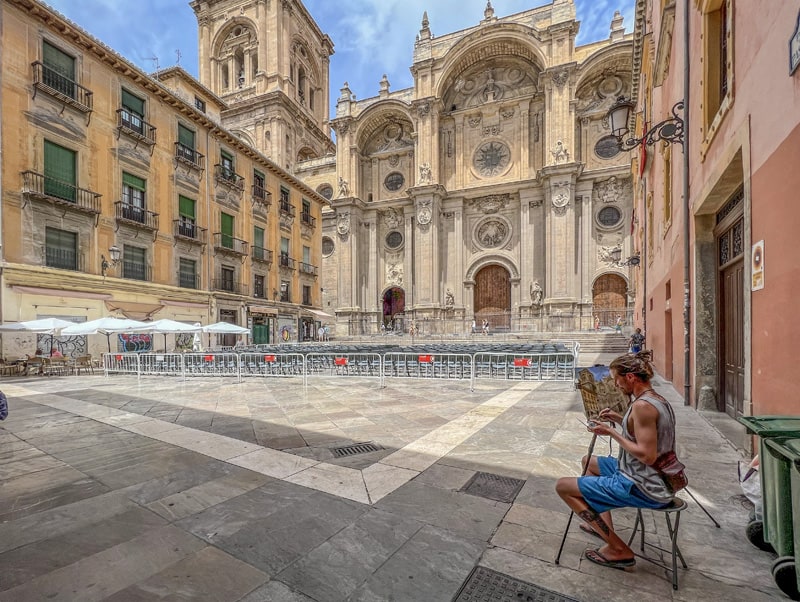
Don’t Miss the Cathedral
In 1492 – the same year Columbus discovered the New World – the armies of Ferdinand II and Isabella I conquered Granada. Thirty-one years after that conquest, they ordered the building of a cathedral in the city, the Cathedral of the Incarnation.
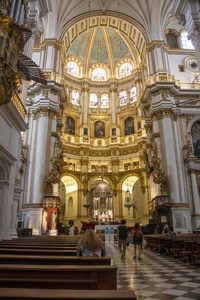
As was often done, it was built over the city’s colossal Mosque. It also took some time to construct (in fact, 181 years), the reason it incorporates Gothic, Renaissance, and Baroque features.
Step inside, and you can’t help but be overwhelmed by its size and beauty. It encompasses a vast space with soaring white pillars, golden balustrades, and a magnificent golden main altar. In addition, it has two large organs, although some pipes are dummies set in place to fill the space between the columns.
Ferdinand and Isabella also ordered the building of their mausoleum, the Royal Chapel (the Capilla Real), in the church. With Carrara figures of the monarchs inside, it remains the most important Gothic building in Granada.
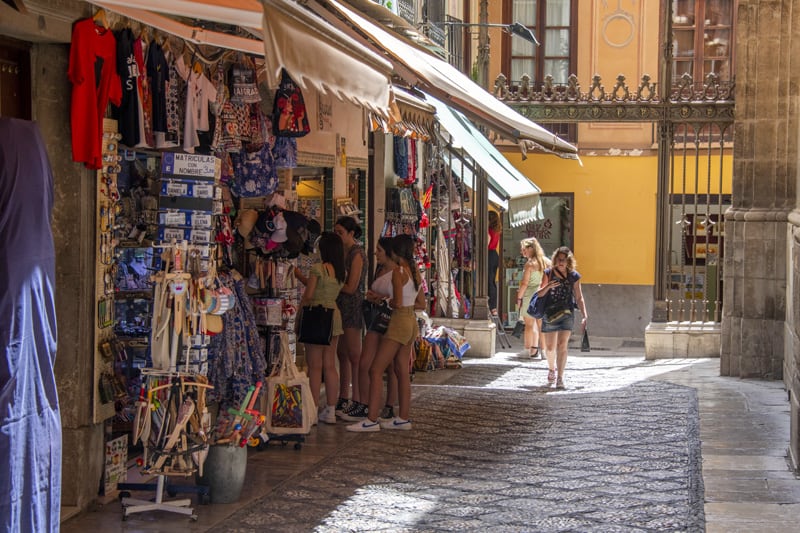
The Old City
After visiting the Cathedral visit the Old City that spreads out about it, which retains the aura of Moorish souks. I just walked about it aimlessly, absorbing the ambiance.
When I left the Cathedral, I headed into the Old Granada, walking down stone steps to the street outside. I couldn’t help but notice how polished they were by shoes and boots of those who had come before me. Moreover, in the glare of the Andalusian sun, they almost looked like silver.
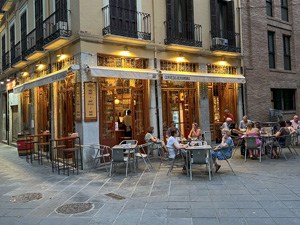
It wasn’t the only surprise I had found. Walking further into the area, I strolled down several main streets shaded by large canopies hung high above. They were fantastic for cutting down the glare and the heat of the midday sun.
A former Moorish warehouse and inn for merchants, both worth seeing, are not far from the Cathedral in the 14th-century Corral del Carbon. A short walk beyond is the Palacio de la Madraza, originally an Arab university. Its hall, with an intricately decorated prayer niche, is now used for art exhibitions.
In this area of Granada, you’ll also find numerous small restaurants and tavernas in addition to its many shops. Many of them are perfect for tasting tapas, the small plates or canapés so much a part of Spanish life. Granada, in fact, is one of the top places in Spain for tapas.
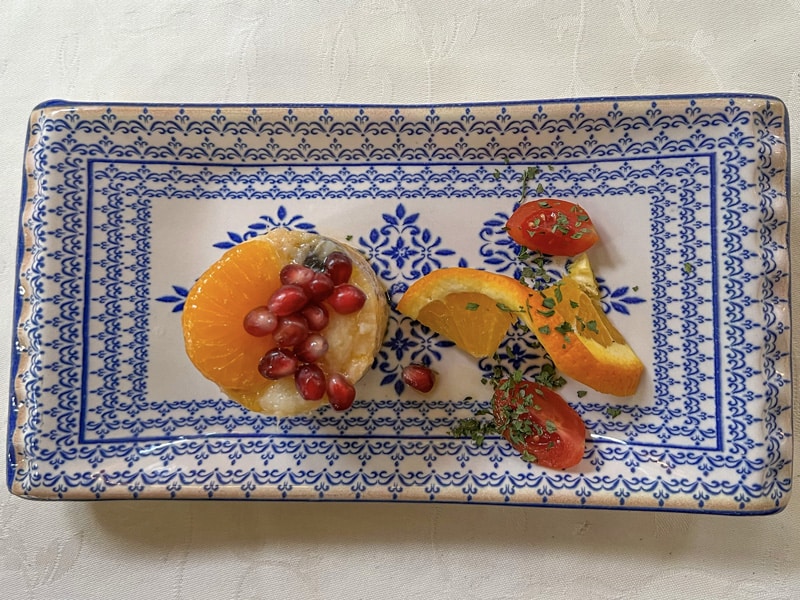
A Tapas Tour of Granada
I planned to join one of the city’s popular tapas tours after my arrival in Granada.
However, the week before, at a conference in Marbella, I met Molly Sears-Piccavey. An ex-pat Brit living in Spain, Molly writes a blog about Mediterranean Lifestyle Food and Travel and designs Spanish Travel Itineraries.
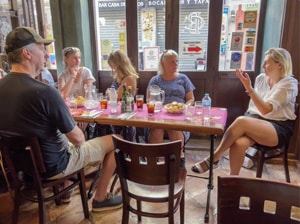
Of more interest to me, however, is that she also runs local food tours in Granada for Spain Food Sherpas, a highly rated organization. So when I heard her mention an upcoming small-group tapas tour in Granada, my ears perked up. I asked if I might join the group.
A week later, I was at the group’s meeting place outside the Theatre Isabel la Catolica near my Granada hotel. It was the start of a delicious evening.
For the next few hours, Molly taught us much about tapas, Spanish food, and the city’s history. (Some of it was surprising, such as learning that most Granada restaurants have their unique brand of vermouth, known as “vermut” in Spanish.)
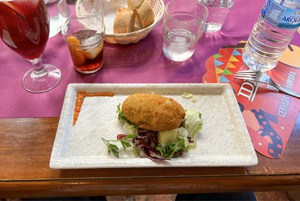
Our first stop was at Casa Castañeda, where we sampled Ham Croquettes, Spinach and Chickpeas with goat cheese, and Spanish Omelettes. Later, in the shop Medieval, Molly explained the culinary impact of herbal Infusions, teas, and spices.
Next, we were off to the gourmet shop Iberica, where we sampled three varieties of ham – one Serrano and two kinds of Iberian. It was quite a revelation to an American who knew nothing about Spanish ham.
We finished our tour at Chikito – with Remojon Granadino (Salt Cod Salad), Fried Artichokes with Molasses, and a Fried Milk Dessert. Some restaurants served us their vermut, each unique.
It was delicious and informative and one of the things I recommend you do in Granada. If you’re not visiting Granada, Molly also hosts food tours in Malaga and Seville. (By the way, in several European cities there are upscale food markets where you can dine on regional foods.)
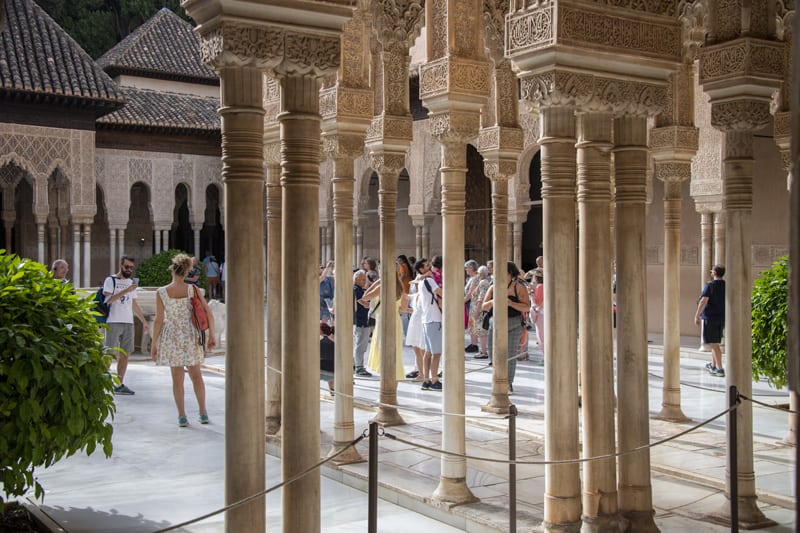
The Alhambra: Important Things to Know Before Visiting
Most likely, one of the top things you’ll want to do in Granada is visit the Alhambra. If so, you first need to understand several critical things.
First and foremost, you should buy your ticket(s) in advance. If you wait to purchase your ticket upon arrival, you could be waiting for hours to enter. Furthermore, in the popular summer months, you might not be able to enter at all.
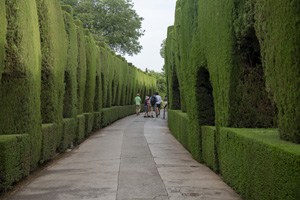
Also, you should buy your tickets only at www.Alhambra-patronato.es, the official ticket vendor. Any other vendor can make no guarantees.
Second, since this is the most popular attraction in Spain, you should book your ticket as early as possible before you travel to Spain. Tickets go on sale a year in advance and are non-refundable or changeable. General admission tickets including both the Alhambra and Generalife are €14 per adult, plus a small service fee.
When purchasing, you must provide an ID number, usually your passport number. You must bring that identification document with you to be matched to your ticket before you’re permitted to enter.
Third, the Alhambra is open to visitors from 8:30pm to 6pm October to March and until 8pm during spring and summer. If possible, book your ticket early in the day, preferably for the 8:30am slot. That’s the best time for avoiding the buses bringing the large tour groups and cruise-ship crowds.
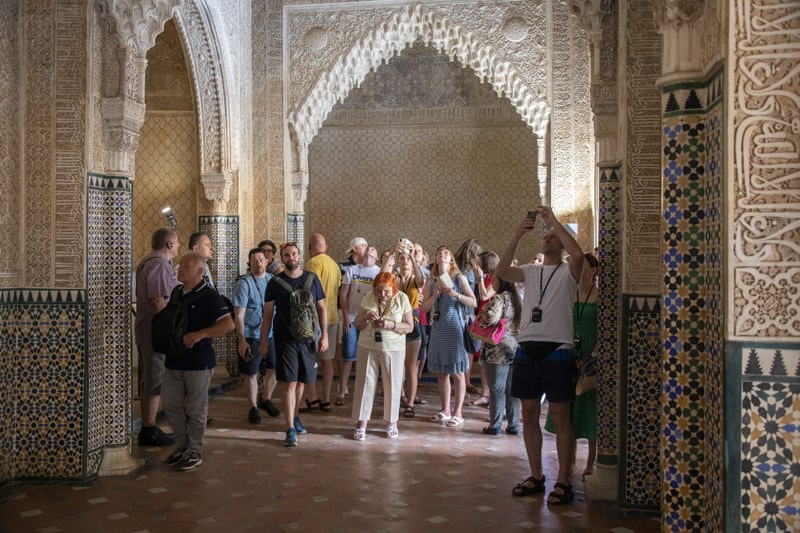
Close to Calamity
Most important to know: all tickets for the Nasrid Palaces, the Moorish palaces inside the Alhambra, are timed in 30-minute intervals. Officials will deny entry if you miss the time stamped on your ticket by even one minute. It almost happened to me.
I had arrived early and wandered into one of the adjoining art museums while waiting for the Palace to open. Unfortunately, when I exited, I didn’t know my way to the Palace and asked for directions.
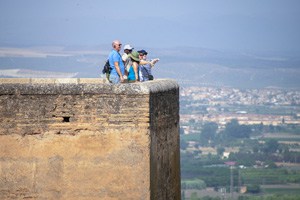
The guard asked to see my ticket and then exclaimed, “Oh no! You only have one minute!” She told me to follow her, and together we ran over to the palace entrance, where she put me behind the last person who was entering. The moral: wait in line at the palace entrance until your entrance time.
And finally, of course, audio guides are also available for €6. But if your interest is in the historical minutia of the Palace and fortress, it’s best to hire a private guide.
You can hire them in advance online (be sure to check the reviews) or through your hotel concierge. You’ll also find them at the entrance to the Alhambra, where you can purchase a tickets. Prices vary.
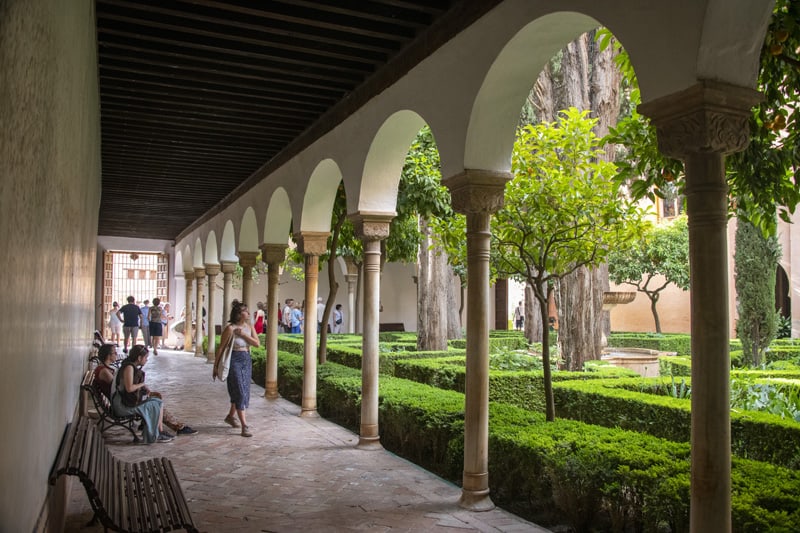
Visiting The Alhambra – the Top Thing to Do in Granada
Without a doubt, visiting the Alhambra is the most popular thing to do in Granada. It’s also the most popular place to visit in all of Spain.
A stunning palace fortress on a hilltop, unless you’re on a tour you’ll need to take a taxi up to it. The cost of the taxi from the center of the city is about €5–€6. When you arrive, you’ll see few signposts telling you where to go.
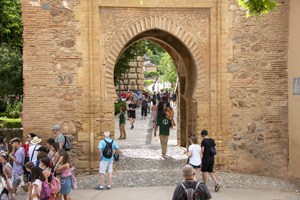
Likely, your driver will advise you to walk down the path to the entrance way. (You can also reach the Ahambra by bus or by walking, but you’ll need to leave ample extra time to arrive at the time stamped on your ticket.)
You’ll need to show your ticket or get in line to purchase one once when you get there. When I arrived, I presented my ticket and was directed to take a seat along the walkway. After a few minutes, a woman checked people’s tickets, telling them, “You have a ticket for 10 o’clock,” “your ticket is for 10:30,” etc. When she came to me, she said, “your ticket is now,” and directed me to a line near the entrance.
Be aware that if you enter after the tour bus groups arrive, you could find things slowing down. But even if you’ve entered at 8:30, you’ll find yourself slowing down just to look at the exquisite marble-work and wood carvings everywhere you turn.
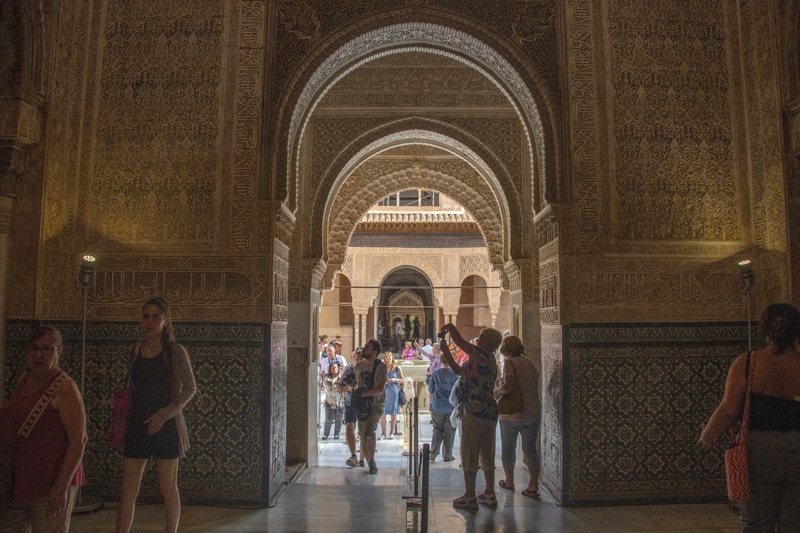
A Visual Feast
Once inside, you’ll immediately realize you’ve entered a visual feast. You’ll be in a warren of rooms and fascinating architecture and design, and outdoor spaces, patios, fountains, etc. It’s hard to get lost since there are sign in every room directing you onward.
Just be cautious as you walk about – it’s often hard to see white marble steps on a white marble floor.
If you enter after the tour bus groups arrive, you could find things slowing down. But even if you’ve entered at 8:30, you’ll find yourself slowing down just to look at the exquisite marble-work and wood carvings everywhere you turn.
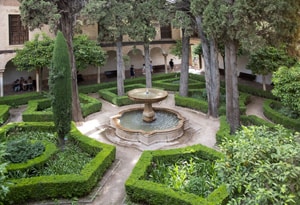
You’ll find many things to see, the most popular being the Hall of the Ambassadors, the reflecting pool in the Court of the Myrtles, and the Court of the Lions. In addition, there are great city and countryside views from the top of the fortress, but this entails a climb that can be problematic for some.
Even with numerous tour groups moving about, everything is serene. You get a feeling that all feel this is a sacred place.
I found this true in the many gardens, as well. Walking about the gardens, I couldn’t help but notice the legion of gardeners I saw along the way, keeping the hedges, bushes, and plants in pristine shape.
Despite the amount of work all about me, I was amazed at how quiet everything was. In fact, all I could hear were the chirps and songs of birds flitting about.
I enjoyed the “small” gardens with many pools and small fountains. Around them are giant cypress trees, ivy-covered walls, greenery everywhere. Beautiful small gardens were tucked away everywhere. In one area, I passed a garden of white snapdragons encircled by rose bushes, each with just one colorful rose.
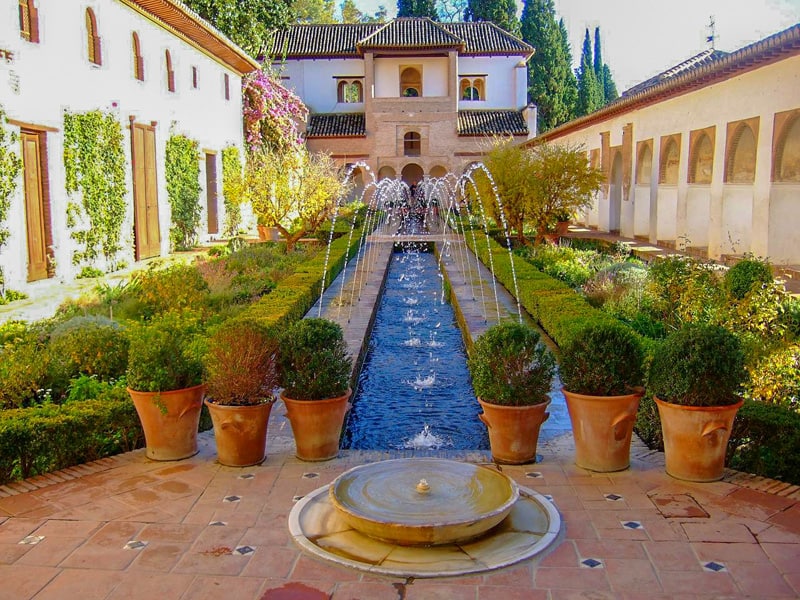
Generalife Gardens
Although you’ll see gardens all about Palace, the most famous gardens in the Alhambra are the Generalife. Set on the Hill of the Sun (Cerro del Sol), the Generalife Gardens are in a word, “spectacular.”
There are different interpretations of the meaning of Generalife Gardens. One is the “Governor’s Garden,” another the “Architect’s Garden,” etc. The latter assumes an architect of the Alhambra lived in a house there during construction. His home would have become the property of the Royal Family later.
It is, however, not the buildings but the gardens that draw crowds here today. Each of the terraces on the hillside is approximately 115 feet wide by 820 feet long. It’s a landscaper’s dream, its beauty stemming from the plants and the ever-changing water that plays with the light.
It does not, however, look now as it did when originally built. It is because it has been altered and rebuilt throughout the Christian period. And despite being very close to the Alhambra, it is considered outside the city.
Nevertheless, the Gardens are so spectacular they have been designated as a UNESCO World Heritage Site.
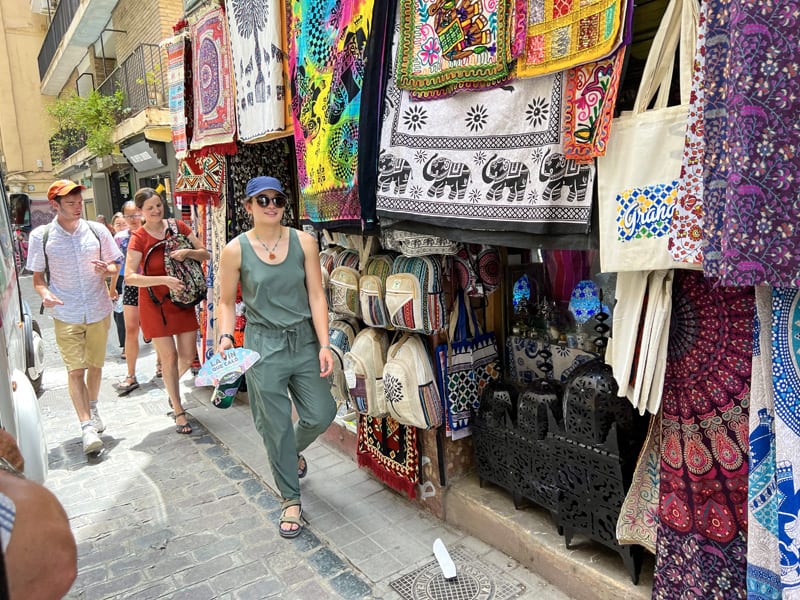
Other Things To Do in Granada
In addition to visiting the Alhambra and perhaps Generalife, spend time exploring Granada’s neighborhoods. In addition to the Old City around the Cathedral, the city’s former Jewish neighborhood, Realejo, is also of interest to many. There you’ll find plenty of local color and, come nightfall, plenty of tapas bars.
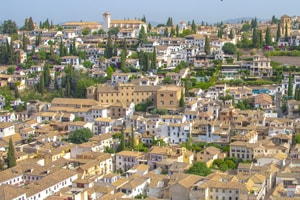
A more popular area, however, is Albaicin, the old Moorish neighborhood that sits below the Alhambra. The third UNESCO World Heritage Site in Granada, its cobbled streets, fountains, and roof mosaics are fascinating. Albaicin is the place where ancient Moorish culture merges with the Andalusian style. Look at the gates and walls of the area to see much of the original Moorish architectural influence.
If you take a taxi to the Alhambra from downtown, you’ll pass through Albaicin on the way to the Palace. You’ll also see it clearly from the fort, although at a distance.
You may also enjoy: Best Things to Do in Seville, Spain’s Seductive City / Segovia, Spain’s Little Treasure / Best Things To Do in Madrid
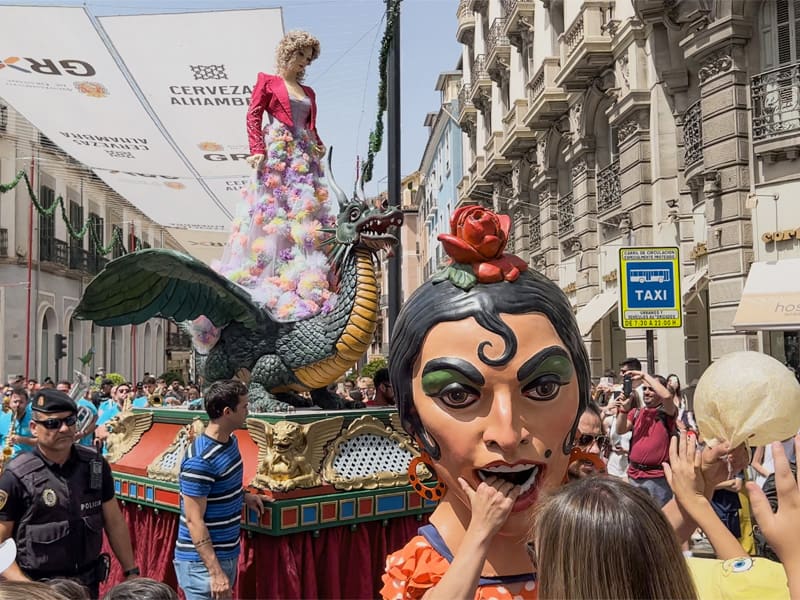
A Parade and A Taverna
After I left the Alhambra, my taxi was stopped in the middle of Granada by a parade. The street was lined by a vast crowd, blocking us from proceeding, and I had to leave the taxi.
I found that the parade is “Tarasca” and takes place Wednesday and Thursday mid-month every June, before the Corpus Christi fair. It was a rather raucous, religious festival with the streets lined with thousands of Granadians.
At the time, not knowing what the parade represented with its pseudo-religious overtone, I walked into a store and asked the clerk what it was. Speaking only limited English (compared to my total lack of Spanish), the woman had difficulty explaining it to me. But then, realizing I was American, she thought for a moment and said, “it’s like the parade when Santa Claus comes.”
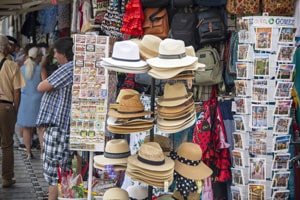
I couldn’t help but think she’d obviously seen photos of New York’s Thanksgiving Day Parade in the media.
That day was a sweltering afternoon, and right after the parade passed, I continued to walk up the street. After about 10 minutes, I found Taverna La Pera across from the Hall of Justice. It was just opening – a bit early for Spaniards, but right on time for tourists – and I became their day’s first customer.
Later, while finishing a salad and glass of cool Albariño, I recalled what I had overheard in the Alhambra earlier. A tour guide shepherding a couple through the complex was telling them what to expect later that day. “In the winter, Granada is a city,” he said, “in the summer, it’s an oven.”
At that moment, on a hot afternoon in June, I couldn’t agree more.
I sat back and ordered another Albariño.

I’m so happy reading your Granada story! It is filled with delicious details that I enjoy reading. I also went on Molly’s fun and amazing food Sherpa tour and can highly recommend it!! I learned so much about the culture and loved the food and places we went. I also walked aimlessly around the Cathedral area. I enjoyed the street musicians and atmosphere. Luckily, I saw the Corpus Christi fair parade and later watched a thrilling outdoor Granada Municipal band concert.